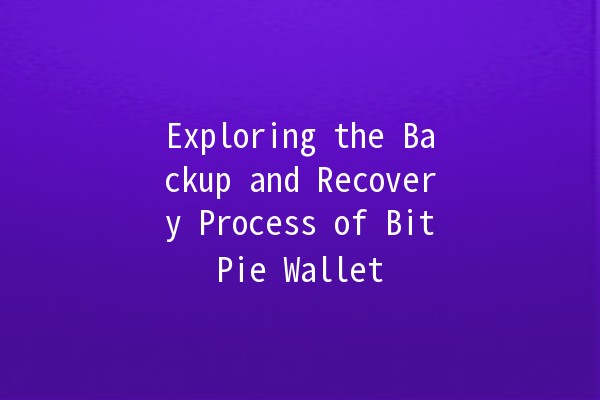
to BitPie Wallet
BitPie Wallet is a versatile and userfriendly cryptocurrency wallet that supports a variety of digital assets. It provides a secure platform for users to store, manage, and trade their cryptocurrencies. However, like any digital asset management tool, it’s crucial for users to understand the backup and recovery processes associated with their wallets. This article aims to provide a comprehensive overview of these processes while offering practical tips to enhance user productivity and security.
Why Is Backup Important? 💡
Before diving into the specifics, it’s essential to emphasize why backing up your wallet is critical:

Key Takeaways
Regular backups are the first line of defense against loss.
Always store backups in secure, but accessible locations.
Backup Process of BitPie Wallet
Step 1: Creating a Backup
Creating a backup in BitPie Wallet involves generating a mnemonic seed phrase. This phrase is a series of random words that act as a master key to access your cryptocurrencies.
Step 2: Verifying the Backup
To ensure that your backup was successful, verify it immediately after creating it.
Step 3: Regular Backups
Consider setting reminders for regular backups. This is especially important after any substantial transaction or any changes made to your wallet settings.
Recovery Process of BitPie Wallet
In the unfortunate event that you lose access to your wallet, the recovery process revolves around utilizing your seed phrase.
Step 1: Install/Reinstall BitPie Wallet
You’ll need to have the BitPie Wallet installed on your device again, whether you are using a new device or reinstalling the app.
Step 2: Initiate Recovery
Once the application is installed, you can begin the recovery process.
Step 3: Verify Wallet Access
ally, doublecheck that all your transactions and balances are intact.
Enhancing Your Backup and Recovery Strategy
Now that we’ve outlined the processes, let’s explore some strategies and tips to enhance your backup and recovery practices:
Tip 1: Use a Physical Backup Medium 🌐
While digital notes are convenient, consider backing up your seed phrase on a physical medium such as paper or a metal plate, which can offer additional durability against fire or water damage.
Tip 2: Implement Redundancy
Maintain several copies of your backup in different locations. For example, keep one copy at home and another in a safe deposit box. This reduces the risk of losing all copies in a disaster.
Tip 3: Keep Your Software Updated
Regularly check for updates to the BitPie Wallet. Keeping the application updated ensures new features, bug fixes, and improved security are in place.
Tip 4: Educate Yourself on Phishing Scams
Be aware of phishing attempts targeting wallet users. Always ensure you are downloading applications from official sources and never share your seed phrase.
Tip 5: Regularly Monitor Account Activity
Frequent monitoring of your wallet’s activity can help detect any unauthorized access immediately. Setting up notifications for transactions can be an effective deterrent.
Frequently Asked Questions
If you lose your seed phrase, unfortunately, you cannot recover your wallet or funds. It emphasizes the importance of maintaining multiple secure backups.
Yes, storing your seed phrase digitally can expose it to potential hackers. Always store it offline and in a secure location.
No, once the seed phrase is created, it cannot be changed. If you want a new seed phrase, you would need to create a new wallet.
Consider backing up your wallet after substantial transactions, any changes to settings, or at least once every few months.
It's generally not recommended. Digital notetaking apps can be vulnerable to hacking. Stick to secure offline storage methods.
Yes, you can restore your BitPie Wallet on multiple devices using the same seed phrase, which allows you to access your funds from different places.
al Thoughts
Understanding the backup and recovery processes for BitPie Wallet is essential for every user to maintain control over their digital assets. By implementing best practices and following the essential steps outlined above, you can significantly minimize the risks associated with cryptocurrency management. Stay updated, remain vigilant, and secure your assets wisely.

